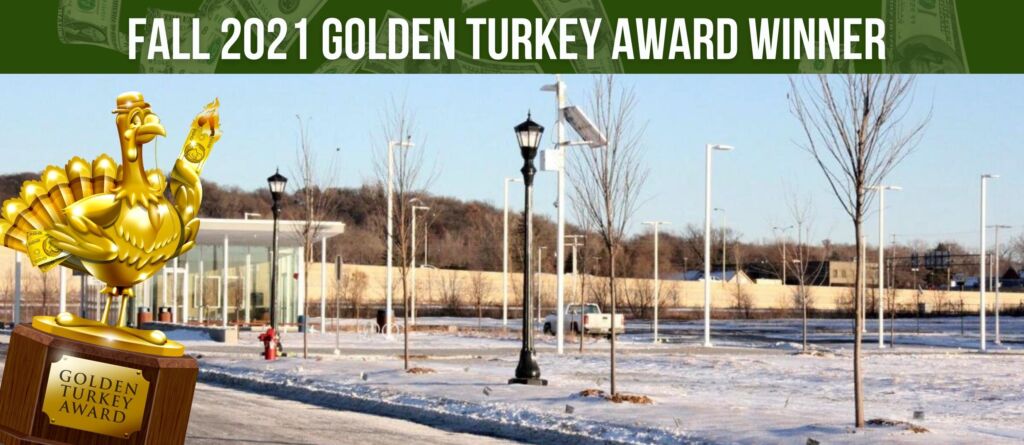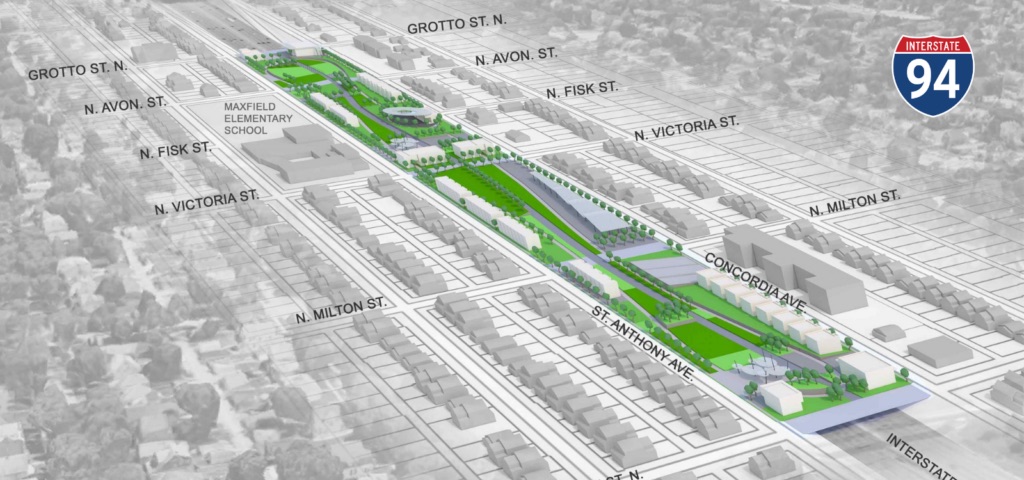The 2021 Golden Turkey Award
Minnesotans vote for the worst examples of government spending
The first three winners of American Experiment’s Golden Turkey Award have been a morgue, a rest stop, and now a park and ride facility — apparently Minnesotans don’t like to waste money on government buildings.
When online voting closed just before Thanksgiving, the Newport Transit Center beat out three other nominees to in the third Golden Turkey Award. This poorly planned park-and-ride facility in Newport cost $6.45 million to build and sits empty just five years after opening.
The Golden Turkey Award is a light-hearted contest to bring attention to the budget and allow Minnesotans to weigh in on the silliest spending of the year. Past winners include Gov. Tim Walz’s $6.9 million unused COVID morgue and the extravagant Goose Creek rest stop on Highway 35 with its curved glass and Brazilian wood architecture.

The Winner: The Buses to Nowhere
The Met Council’s $6.45 million Newport Transit Center sits empty and unused.
For the first time, the Golden Turkey award committee allowed nominations from the public and Minnesotans did not disappoint with their ideas. The most popular category of the public nominees was wasteful transit projects such as the Rush Line in White Bear Lake or Southwest light rail in Eden Prairie. Representing all wasteful transit boondoggles, the Newport Transit Station won the Fall 2021 Golden Turkey award.
The Newport Transit Station opened in November 2014 with a cost to taxpayers of $6.45 million. In July 2017 the Pioneer Press called it the “Hilton Hotel of bus stops” in an article titled “The east metro’s most expensive park-and-ride station is also the least used.” At that time, the Met Council boasted ridership of eight passengers a day on the bus lines serving the Newport Transit Station. The two routes serving the station go to downtown Minneapolis and downtown St. Paul. The Met Council could only dream of such high numbers today because in the post-COVID world, there are no buses serving this sprawling transit stop. So its 150-car parking lot is empty and desolate.
As in all of these transit projects, urban planners sat in their office cubicles and dreamed of “transit-oriented development” along the line to boost ridership and attract people to new high-density neighborhoods with coffee shops and brewpubs. Except commuters in Washington County, like every other suburban area served by the
Met Council, like to drive cars and don’t generally work in the downtowns, especially post-COVID. So far, no new development has occurred apart from one apartment building overlooking the empty lot.
The bottom fell out of transit ridership during the pandemic and while highway traffic has returned to pre-COVID levels, the same cannot be said for buses and trains. The Met Council is silent on this giant goose egg, as they wait for a Minnesota Legislature-directed study from the University of Minnesota analyzing changes in ridership, public transportation demand, and revenue and expenditures.
“The problem with the Newport bus stop is that no buses actually stop there,” said John Hinderaker, president of Center of the American Experiment. “This project was doomed from the start with poor ridership numbers and when the pandemic hit, Metro Transit locked the door and stopped sending buses.”
Which leaves the Newport Transit Station with an empty 150-car parking lot and a Golden Turkey trophy.
1st Runnerup: ‘Violence Interrupters’
Minneapolis paid citizen groups $2.5 million to patrol neighborhoods instead of police.
One of the most visible responses to the dramatic increase in violent crime in Minneapolis has been the city’s attempt to “interrupt” crime by hiring citizen groups in brightly-colored t-shirts to patrol the streets. Grants to hire teams of well-meaning “violence interrupters” were awarded to seven local community organizations with a $2.5 million annual appropriation from the city council. Team members are paid $30 per hour and work five-hour shifts, six nights a week patrolling the streets on foot.
In more peaceful times, working with community groups to prevent violence sounds like a worthy endeavor. But in Minneapolis circa 2021, diverting $2.5 million a year from the police budget for anything that doesn’t involve arresting and prosecuting the people committing violent crime is insane. Which is why this expenditure was nominated for a Golden Turkey award.
When the program was launched, City Council Representative Phillipe Cunningham told WCCO TV: “The intention is for this to actually stop the violence, stop the guns from being shot so that the police don’t even have to show up in the first place.” Perhaps support for this program is one of the reasons Cunningham lost his seat on the council on November 2nd.
One “violence interrupter” was fired after a video emerged showing him beating up a customer at Cub Foods. Another was arrested for assaulting a customer at a separate Cub Foods store. Cub recently replaced off-duty police officers with peace workers for store security.
Even liberals who supported the abolish-the-police movement are not convinced the violence interrupter approach is working. One of the groups receiving funding, We Push for Peace, was recently ridiculed on Twitter for “standing by the food trucks and bars in Uptown eating.”
The headlines and murder rate do not support city officials’ claim that the violence interrupter idea is an evidence-based scientific approach to combat, let alone “interrupt” violence. In a telling sign, the Minneapolis violence interrupters were abruptly pulled from the streets in November 2020 as violence intensified. The city said it was due to cold weather (cough cough).
As the city experienced record crime rates for murder, carjacking and other violent behavior, Minneapolis doubled down on the 2020 pilot program and put teams of violence interrupters back on the streets for the summer of 2021. The epic failure of this program is worthy of a Shakespearean tragedy and a Golden Turkey nomination.

2nd Runnerup: Bridging History
The legislature spends $6.2 Million to plan a $500 million land bridge over I-94.
You know how your radio goes out when you drive through the Lowry Hill tunnel? Imagine another tunnel twice as long running for a half mile on I-94 in St. Paul. That’s right. The legislature is looking at a $500 million “land bridge” over I-94 from Lexington Avenue to the Capitol. Of course, the $500 million is only an estimate. It’s a safe bet the final cost of the infrastructure necessary to cover a half mile of interstate will double faster than you can say “Southwest Light Rail.”
It’s being built to try to right a wrong that allegedly happened 60 years ago when the highway was built through a mostly black neighborhood. What could possibly go wrong when government tries to “right past wrongs” and “make up for long overdue social justice” with a $500 million project? Of course, the highway ran through white neighborhoods too, but no “land bridges” are planned in those areas.
The Minnesota Legislature tucked $6.2 million into the 2021 Tax Bill for project development of a “land bridge freeway lid over marked Interstate Highway 94 in a portion of the segment from Lexington Avenue to Rice Street in St. Paul.”
This is always how these projects begin: with a relatively small appropriation to set up an office, hire staff, study the problem, survey “stakeholders” and get “preliminary engineering” done. There is always preliminary engineering.
The problem is, once we spend that money, they come back for more, saying: “We can’t let the first money go to waste, we have to keep going.” And before long, it’s a billion dollars.
The proposed tunnel will be over a half-mile long, twice the length of the Lowry Hill tunnel in Minneapolis. Several questions remain unanswered, including where to reroute trucks carrying hazardous materials and how to prevent car accidents, since tunnels are notoriously dangerous.
Perhaps the biggest question is how planners will accomplish their goal of creating an “equitable future” for the site and avoid gentrification? In other words, how do you recreate an historic black neighborhood if a bunch of white millennials end up renting all the new apartments? A rift has already developed among community leaders over this challenge.
The sheer magnitude of this project and its Critical Race Theory-inspired purpose earned the Highway 94 land bridge a Golden Turkey award nomination.

3rd Runnerup: Scaring the Eagles
The ‘U’ gets a quarter million to find a noise that will deter the birds from flying into windmills.
We return to one of our favorite silly spending funding sources, the Legislative Citizen Commission on Minnesota Resources (LCCMR) for another Golden Turkey nominee. This one is for a $261,000 grant to the University of Minnesota to design and implement “an acoustic deterrence protocol to discourage bald eagles from entering hazardous air space near wind energy installations.” In other words, we need to discover a noise annoying enough to scare bald eagles from their untimely demise at the hands of wind turbine blades moving up to 100 miles per hour.
Don’t get us wrong, the Golden Turkey award committee is full of bird lovers – we named our award for one, after all. We also love America and believe in protecting bald eagles. But this approach is backwards. The problem of bald eagles running into windmills is largely created by governments subsidizing the proliferation of windmills. Their application for grant funding begins with the claim: “Wind energy is a cost competitive, clean energy source that offers benefits for Minnesota.” No, it isn’t.
No one has written more about the folly of alternative energy than American Experiment. Without government subsidies, the industry would still consist of a few scattered windmills on small hobby farms run by hippies. Xcel Energy’s recent announcement of a 22 percent rate hike is largely needed to build out the costly infrastructure necessary to connect these bald eagle killing machines to the grid.
For these obvious reasons, this project was nominated for a Golden Turkey award.
* * *
Golden Oldies: What happened to past Golden Turkeys?
Walz morgue for sale at $1.25 million loss.
Minnesotans recognized the wasteful spending on Tim Walz’s morgue even as COVID cases grew in 2020 during the contest. After using the morgue to create a statewide panic that forced people to retreat into their homes for months, Walz recently announced they are looking to sell the morgue and taxpayers stand to lose money on our ill-fated purchase.
With $6.9 million invested and a proposed sale price of $5,650,000, the state stands to lose over a million dollars when the dust settles. But what price should we put on the fear needed to convince Minnesotans to give up our freedoms, close businesses and schools, and force children to wear masks? The Walz morgue will go down in history as a monument to both stupid spending and poor leadership in a crisis.
Duluth doubles down on Spirit Mountain ski slope.
The Spirit Mountain ski hill in Duluth came in fourth place in the Spring 2021 Golden Turkey contest, but a new proposal from Mayor Emily Larson to double down on failure with another $24 million could make this boondoggle the first two-time nominee in Golden Turkey history.
Mayor Larson announced last week an ambitious $24 million plan to revitalize Spirit Mountain, saying, “We cannot get out of this, so we are going to get into it.” Brilliant. The great economic concept of “if we build it, they will come” might work in the movies, but not with government subsidies. No bank would consider loaning a ski hill with Spirit Mountain’s track record any money. Minnesota taxpayers shouldn’t either.